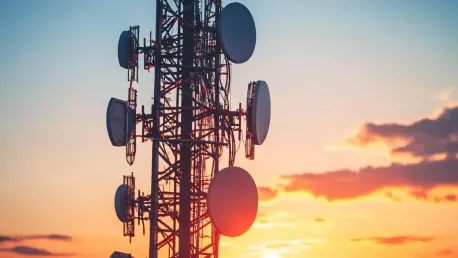In a groundbreaking development by researchers at Princeton University, Rice University, and Brown University, a low-cost system has been introduced that aims to transform industrial machine communication. This innovative technology eliminates the need for energy-consuming signal transmitters by operating in the sub-terahertz frequency range. It represents an advanced version of a device known as a tag, which is utilized for wirelessly transmitting data. At the core of this innovation is the use of sophisticated backscattering techniques at sub-terahertz frequencies, facilitating efficient data transmission across extensive networks of devices.
The Innovation of Sub-Terahertz Backscatter Technology
Overcoming Traditional Backscatter Limitations
The technology revolves around a tag that enables data transmission via backscattering, where a central reader sends a signal to a sensor tag to gather information. The tag then reflects this signal back to the reader. Historically, backscattering has been limited to lower frequencies, which posed significant challenges such as slow communication speeds and increased signal interference when multiple devices attempted to communicate simultaneously. Lower frequency signals suffer from bandwidth restrictions, curtailing the amount of data that can be transmitted swiftly. Additionally, the probability of signal collision rises with the number of devices trying to communicate within the same frequency band.
These limitations hampered the scalability and efficiency of traditional backscatter systems, particularly in environments where numerous devices must share the same communication channels. As a result, expanding such networks to include more devices often led to decreased performance and reliability due to these interference issues. Lower frequency backscatter systems often also necessitated more robust infrastructure and power consumption to handle the load, further hindering their practicality in various applications.
Advancements in High-Frequency Communication
The new generation of tags, however, operates within the sub-terahertz frequency range, which is a high-frequency segment of the radio spectrum. This breakthrough enables rapid data transmission across broad bandwidths, allowing for seamless communication among densely packed devices while maintaining low energy consumption and minimizing infrastructure costs. Operating at these higher frequencies was previously challenging due to difficulties in maintaining signal integrity over longer distances and the need for precise beam formation.
Signal propagation at sub-terahertz frequencies requires advanced antenna systems that can flexibly adjust and direct the signal to ensure consistency and avoid degradation. This advancement opens up new possibilities for high-speed wireless communication in environments where quick data exchange is critical, from industrial automation to smart urban infrastructure. Leveraging the high-frequency range allows more extensive data transmission without the signal clutter and interference common in lower frequencies, making it particularly suitable for applications where large amounts of data need to be rapidly transmitted and processed.
Technical Innovations and Practical Applications
Novel Antenna Structures and Frequency Agility
Yasaman Ghasempour, an assistant professor of electrical and computer engineering at Princeton and the study’s principal investigator, emphasizes that the new technology’s frequency agility demonstrates that low-power, scalable communication can indeed be achieved in the sub-terahertz range. Traditional backscatter systems typically employ antennas that broadcast signals omnidirectionally, which results in significant energy dissipation and reduced efficiency. These systems also lack effective directional control over the transmitted signals, further impacting their performance.
The new system addresses these issues by incorporating a novel antenna structure that dynamically adjusts the signal’s direction in response to frequency changes. This enhances the communication range and reduces interference from other signals, leading to more efficient and reliable data transmission. The ability to steer signals adaptively based on frequency shifts not only improves signal integrity but also supports the creation of more complex and densely packed networks where multiple devices can communicate simultaneously without significant interference.
Industrial and Urban Applications
The practical applications of this technology are both vast and diverse. In industrial settings, the system could enable real-time monitoring of machinery, facilitating predictive maintenance and reducing downtime. It could also be used for detecting gas leaks, thereby enhancing operational efficiency and safety. In urban environments, the technology has the potential to transform smart city infrastructure by enabling extensive sensor networks that monitor air quality, traffic flow, and other critical parameters.
Such networks could provide valuable data for urban planning and management, improving both the quality of life and environmental performance of cities. In the agricultural sector, these tags could establish networks of soil sensors that provide real-time information on moisture levels and temperature, optimizing irrigation and crop management. This would lead to more sustainable farming practices and increased agricultural productivity by ensuring that resources are used efficiently and effectively based on accurate, real-time data.
Future Prospects and Ongoing Research
Enhancing Communication Efficiency
The researchers’ work, published on October 9 in Nature Communications, represents a crucial milestone in reducing the costs and power consumption of wireless communication systems. It challenges traditional assumptions about sub-terahertz communications’ limitations, proving that low-power, scalable communication is viable within this frequency range. The new tag system was engineered from the ground up, featuring innovative antennas that automatically adjust to frequency changes to optimize signal direction and minimize interference, resulting in an extended communication range.
This approach effectively mitigates spatial and spectral interference, making it feasible to operate large-scale networks without substantial signal degradation or increased power requirements. The researchers believe that further advancements, such as integrating low-cost signal amplifiers, could significantly enhance this technology, leading to more efficient and robust sensor networks across various applications. These improvements would make it possible to expand the use of sub-terahertz backscatter communication systems to even more strenuous and diverse environments.
Potential for Autonomous Systems and Environmental Monitoring
One particularly promising future application of these tags is in enhancing communication with self-driving cars. By embedding these tags in traffic signs, radio waves could convey essential messages such as “stop” or “yield” to autonomous vehicles under poor visibility conditions. This would significantly improve the safety and functionality of autonomous driving systems, ensuring they can operate reliably even in challenging weather conditions like fog or snow.
The technology could also support widespread environmental monitoring networks, providing crucial data on soil health, weather conditions, and pollution levels. This information would be vital for environmental conservation efforts and sustainable agriculture practices, helping monitor and manage natural resources more effectively. These applications demonstrate the far-reaching potential of sub-terahertz backscatter technology in addressing significant contemporary challenges and promoting sustainable practices across various sectors.
Collaborative Research and Technological Impact
Engineering Improvements and Scalability
The research, spearheaded by Ghasempour along with authors Atsutse Kludze, Junichiro Kono, and Daniel M. Mittleman, indicates that developing effective low-power modulators within these networks remains a critical area for ongoing research. The innovations outlined in this study signify a substantial leap in the scalability and efficiency of wireless communication systems, paving the way for diverse future applications. This collaborative effort highlights the importance of interdisciplinary research in addressing complex technological challenges and achieving significant breakthroughs.
The continuous development of these sub-terahertz systems promises to push the boundaries of what is possible in wireless communication, potentially leading to more sophisticated and efficient networks. Researchers are confident that with further engineering refinements, these systems will become even more robust, scalable, and cost-effective, unlocking new possibilities for wireless data transmission and control in various settings.
Revolutionizing Data Transmission and Monitoring
In a groundbreaking advancement by researchers at Princeton University, Rice University, and Brown University, a low-cost system has been developed to revolutionize industrial machine communication. This pioneering technology operates in the sub-terahertz frequency range and eradicates the need for energy-consuming signal transmitters. Essentially, it is an advanced version of a device called a tag, which is employed for the wireless transmission of data.
The core of this innovation lies in the use of sophisticated backscattering techniques at sub-terahertz frequencies, which enable highly efficient data transmission across widespread networks of devices. What sets this system apart is its potential to significantly reduce energy consumption in industrial communications, paving the way for more sustainable and efficient operations. This cutting-edge development could usher in a new era of connectivity, improving the integration and performance of industrial machines by allowing them to communicate more effectively without the heavy energy costs traditionally associated with such systems.









